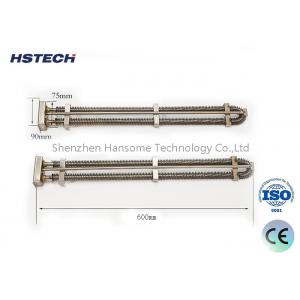
Add to Cart
JT Reflow Soldering / Wave Soldering Heating Wire High-Efficiency Heating Tube
Introduce
Heating wire is the most common type of heating element. Its function is to generate heat after being energized and convert electrical energy into thermal energy.
Reflow soldering is a group or point-by-point soldering process in which an appropriate amount and form of solder is placed in the PCB soldering area in advance, and then the surface mount components are placed, using an external heat source to reflow the solder to meet the soldering requirements.The heat required during the working process is provided by a large number of heating wires installed in the reflow soldering machine. Therefore, the heating wire is an important part of the reflow soldering machine.
Feature
| Compact size | Heating wires have a smaller volume compared to traditional heating elements, making them suitable for designing electronic devices and circuit boards with limited space |
| Lightweight design | As heating wires are usually made of lightweight materials, they do not increase the load on the equipment and are suitable for scenarios that require lightweight design. |
| Rapid heating | Due to its small size and high efficiency in energy conversion, the heating wire can quickly achieve heating, improving the response speed and efficiency of the equipment. |
| Low power consumption | Due to the efficient energy conversion of the heating wire, it can achieve the required heating effect at a lower power, which helps to save energy and extend battery life. |
| High reliability | The heating wire is fixed on the PCB through surface welding technology, and the connection is firm and reliable, not easily affected by vibration and impact, improving the stability and durability of the equipment |
Size selection




Detail display


Product Display


For the treatment of heating wires, the following steps are usually included:
1.Select appropriate heating wire specifications: Based on specific application requirements and design requirements, select SMT heating wires of appropriate specifications, including size, resistance value, power, working voltage and other parameters.
2.PCB design and layout: In the PCB design stage, it is necessary to reasonably layout the position of SMT heating wires and ensure coordination with the layout of other components to ensure the normal operation and stability of the circuit.
3.Welding process: Use surface mount technology (SMT) to solder the heating wire onto the surface of the PCB. This usually involves precise control of welding temperature, time, and pressure to ensure welding quality and stability.
4.Quality inspection: After welding is completed, the welding quality is inspected and tested. This includes visual inspection, welding connectivity testing, as well as resistance and power testing.
5.Assembly and packaging: Assemble the soldered PCB into the device and package it to ensure the safety and reliability of the heating wire and other components.
6.Testing and debugging: Test and debug the entire circuit to ensure that the SMT heating wire can work properly and meet design requirements and performance indicators.
7.Application and maintenance: After the equipment is put into use, regularly inspect and maintain the SMT heating wire to ensure its normal operation and long-term stability.
By following the above processing steps, the reliability and performance of SMT heating wires in electronic devices can be ensured, thus providing an effective heating solution.